Plan checklist
The Lam Property
1111 Buckeye Road #10, Stewart Lake
Planting plan created by The District Municipality of Muskoka
Schedule A:
Plants & Property
Land Characteristics
This planting plan is designed based on the land characteristics identified during the day of the site visit. Plants are chosen according to the soil and light conditions on your property. The number of plants chosen for each planting compartment takes into account the square metre area of the space, as well as the amount of current vegetation cover. Your property is part of ecoZone: 5a
Land Characteristics by Compartment
| Length | Width | Area | pH | Soil | Moisture | Light | Height | |
|---|---|---|---|---|---|---|---|---|
| A | 0m | 0m | 0m2 | acidic | sandy, loamy | normal, moist | partial sun | |
| B | 0m | 0m | 0m2 | acidic | sandy, loamy | normal, moist | partial sun | |
| C | 0m | 0m | 0m2 | acidic | sandy, loamy | normal | partial sun, shade | |
| D | 0m | 0m | 0m2 | acidic | sandy, loamy | normal | partial sun | |
| E | 0m | 0m | 0m2 | acidic | sandy, loamy | normal | partial sun | |
| F | 0m | 0m | 0m2 | acidic | sandy, loamy | normal, moist | partial sun | |
| 0m | 0m | 0m2 |
Plant Selection Summary
The following shrubs and trees are chosen for their suitability and survivability given the current soil and light conditions in each compartment on your property, as well as preferable features.
| Plant Species | A | B | C | D | E | F | Potted | Bareroot | Wildflower |
|---|---|---|---|---|---|---|---|---|---|
| Sweet Gale | 3 | 2 | 5 | ||||||
| Steeplebush | 5 | 6 | 3 | 14 | |||||
| Red Osier Dogwood | 2 | 1 | 3 | ||||||
| Nannyberry | 2 | 1 | 3 | ||||||
| Ostrich Fern | 13 | 12 | 3 | 7 | 6 | 6 | 47 | ||
| Eastern White Cedar | 1 | 1 | |||||||
| Ninebark | 1 | 2 | 3 | ||||||
| Alternate-Leaved Dogwood | 1 | 1 | |||||||
| Witch Hazel | 1 | 1 | 1 | 3 | |||||
| Bush Honeysuckle | 3 | 5 | 3 | 11 | |||||
| Narrow Leaved Meadowsweet | 2 | 2 | |||||||
| Wild Geranium | 3 | 3 | 6 | ||||||
| Canada Yew | 2 | 2 | 1 | 5 | |||||
| Bracted Honeysuckle | 3 | 3 | 6 | ||||||
| Gray Dogwood | 1 | 1 | |||||||
| Canadian Serviceberry | 1 | 1 | 2 | ||||||
| Chokecherry | 1 | 1 | |||||||
| Black Chokeberry | 1 | 1 | |||||||
| Purple Coneflower | 3 | 3 | |||||||
| Oswego Tea (Red Bergamot) | 3 | 3 | |||||||
| Black-Eyed Susan | 3 | 3 | |||||||
| Wild Bergamot | 3 | 3 | |||||||
| Subtotal | 25 | 22 | 14 | 20 | 23 | 23 | 109 | 0 | 18 |
| Totals | 127 | ||||||||
Plant Information
The following table summarizes key information about each plant selected for your property.
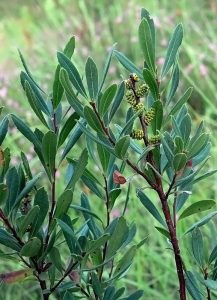
|
Sweet GaleHeight: 1-2m
Sweet Gale is a medium-sized shrub which grows into a thick bush about 1-2 m tall. This species produces 1-8 cm long, oblong-lanceolate leaves which are finely toothed at the tip and are spirally arranged. When bruised, these leaves give off a pleasant aroma. Male and female catkins are produced on separate plants. The seeds are dispersed from the female plants via water, as they float on two corky bracts. This shrub also provides a good food source for bird species that eat the seeds including Grouse, Chickadees, and Bluebirds. Mammal species like Beavers and White-Tailed Deer also browse on the twigs and leaves of this plant.
|
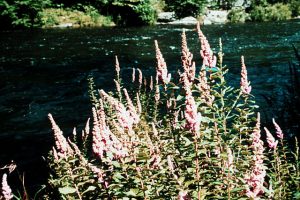
|
SteeplebushHeight: 1 m
The Steeplebush is a deciduous shrub species that typically grows about 1 m in height . This plant may also be known by the common names: Rose Spiraea or Hardhack. The leaves are dark green, about 7 cm long, elliptic to ovate shaped, have toothed margins, and have dense yellowish brown hairs on the undersides. The flowers are tiny, rose pink to purplish coloured, bloom in late summer, and appear on tall, dense, steeple shaped clusters. This plant is useful for controlling erosion and stabilizing shorelines. The flowers are also beneficial for pollinator species, like bees and butterflies.
|
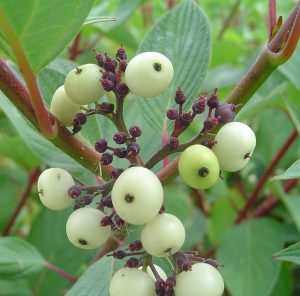
|
Red Osier DogwoodHeight: 1.5-4m
The Red Osier Dogwood is a medium-sized, deciduous shrub native throughout Northern and Western North America which typically grows to 1.5-4m. This species is multi-stemmed with numerous erect and ascending bright red branches that create a loose and spreading form. Leaves produced are simple, two-toned with a dark green upper side and light green underside. They are arranged opposite each other along the branches. During the fall, the foliage turns a brilliant red to dark purple. Clusters of small, creamy white flowers form on the terminal ends of the branches between June and July. The Red Osier Dogwood produces blueish-white fruiting bodies during late summer, which may persist throughout the winter. This shrub's berries provide an important winter food source for numerous species, from large deer to small wintering birds.
|
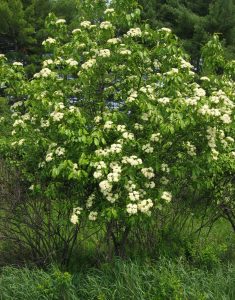
|
NannyberryHeight: 3 m
Nannyberry is a large deciduous shrub species that typically grows about 3 m in height. The leaves are dark green, ovate shaped, oppositely arranged, have a pointed tip, and have finely toothed margins. The flowers are showy, white colored, appear in flat topped clusters, and bloom in May. These flowers produce blueish black berries, which are edible to humans and persist throughout the winter. The flowers are beneficial to pollinator species , like bees and butteries. The fruit is beneficial to wildlife species, including birds and small mammals. This shrub has attractive fall foliage. The root system is extensive, making this plant valuable for controlling erosion and stabilizing loose soil. This shrub can be pruned to have a single stem and grown as a small tree instead of a shrub.
|
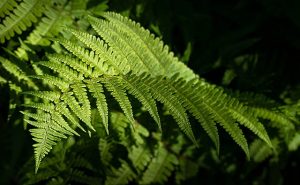
|
Ostrich FernHeight: 1.5 m
The Ostrich Fern is a coarse, erect to arching perennial fern, that can grow up to 1.5 m in height. The stems are clustered and arching while the leaves are ostrich-plume shaped, widest near top, and very gradually narrowed to the base. The size of the leaves grow up to 1.5 m long and 12-40 cm wide, with around 40 pairs of leaflets or pinnae. The leaflets are long, narrow-pointed, and ascending. The leaves are fertile, with spore clusters on the undersides of sub-leaflets.
|

|
Eastern White CedarHeight: 15m
Eastern White Cedar is a small evergreen tree which can usually live up to 300 years, although some individuals reaching 700 years old have been found. White Cedar produces unique green, opposite, scale-like leaves, which can take a fan-shaped form. They typically grow 15m in height. The bark is also distinguishable as it is reddish-brown, stringy and flaky, making it easy to peel off into long strips. White Cedars are also prone to heart-rot, leaving many trees with hollow centres. However, dried cedar bark is decay resistant making it a great option for use as fence posts or cedar-strip canoes. In addition, this species was historically used by indigenous people to prevent scurvy, earning the name 'tree of life'.
|
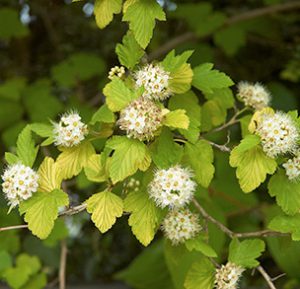
|
NinebarkHeight: 2-3m
The Common Ninebark is a very hardy, large (2-3m in height), deciduous shrub naturally occurring within riparian zones. This species is often planted as an ornamental shrub for its exfoliating bark which reveals reddish-light brown inner bark. This shrub is multi-stemmed with numerous horizontal and ascending branches creating a full, round shape. The Common Ninebark produces dull green, ovate to round shaped leaves with three to five lobes per leaf. During the fall the leaves turn brilliant yellow or dark purple. Between May and June, showy, bell-shaped flowers bloom in clusters on the terminal ends of the branches. During the summer, these flowers give way to small green or green-yellow berries which turn a bright red upon ripening.
|
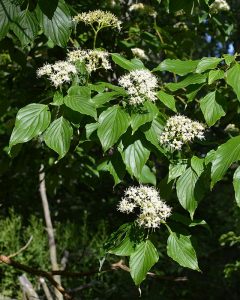
|
Alternate-Leaved DogwoodHeight: 5-10 m
The Alternate-Leaved Dogwood is a tall, deciduous shrub or small tree species that can grow 5-10 m in height. This plant may also be known by the common name Pagoda Dogwood. It can be grown either in the form of a single stem tree or multi-stemmed shrub comprised of two or three smaller trunks. The leaves are ovate shaped, alternately arranged, have prominent veins, have a pointed tip, and have entire margins. The flowers are showy, fragrant, whitish yellow, appear in flat clusters, and bloom between May and June. These flowers produce clusters of dark blue berries. The flowers are beneficial for pollinator species while the berries are beneficial for wildlife species. The root system is valuable for controlling erosion and stabilizing loose soil. This plant is often used as a small ornamental tree in landscaping. The common name comes from the fact that all other Dogwood species have oppositely arranged leaves.
|
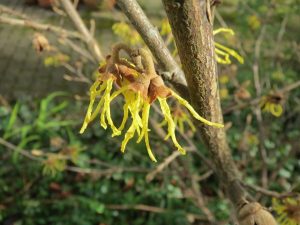
|
Witch HazelHeight: 4-9m
The Witch Hazel is a deciduous understory shrub, with a broad and rounded crown which typically grows 5-9m. This species can sometimes take on the form of a tree. Witch Hazel is most recognizable for its 2 cm long, spidery, bright yellow flowers, which bloom during late fall. Leaves produced are alternate, simple, 6-15 cm in length, and obovately shaped. These leaves are dark green on top with paler undersides and turn yellow during the autumn. Witch Hazel leaves produce hairs on their principal veins, are asymmetrical at their base, scalloped, and sometimes coarsely toothed. In addition, the leaves contain 5-7 straight, parallel, ascending veins per side. The twigs are slender, zigzagged, tawny, and smooth when mature. Witch Hazel fruiting bodies are short, thick, light brown capsules that become woody upon maturation. This species is typically multi-stemmed with two or more trunks, which are crooked and 10-15 cm in diameter.
|
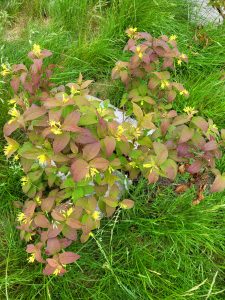
|
Bush HoneysuckleHeight: 1m
The Bush Honeysuckle is a small, hardy, deciduous shrub that rarely grows taller than 1 m in height. The leaves are simple, oppositely arranged, ovate shaped, and have finely toothed margins. During the spring and summer, the leaves are dark green in colour, then in the fall they take on a variety of colours ranging from a deep purple to light yellow. The flowers are small, showy, yellow to orange colored, trumpet shaped, appear in clusters on the tips of branches, and bloom between June and July. The flowers are beneficial to pollinator species, including hummingbirds and butterflies. The roots of the Bush Honeysuckle are fibrous, giving it the ability to form thickets and making it an ideal shrub to plant for erosion control.
|
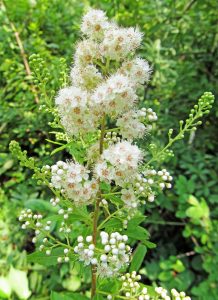
|
Narrow Leaved MeadowsweetHeight: 1-2m
The Narrow Leaved Meadowsweet is an erect, deciduous shrub, which grows in the shape of a mound to a height of 1-2m. This species develops numerous branches and branchlets, giving it a sparse appearance. Leaves produced are simple and narrow with sharply toothed borders growing alternately along the branches. These bright, light green leaves appear crowded, as they grow close together on the stocks and branches. During the fall, leaves turn a yellow-red or yellow-orange colour. Small white to light pink flower clusters appear in the spring growing in a dense, narrow pyramid at the terminal ends of the branches. During late summer to early fall, these flowers produce smooth, papery seed pods.
|
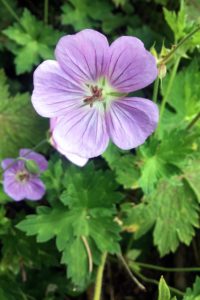
|
Wild GeraniumHeight: 70 cm
Wild Geranium is a herbaceous perennial wildflower species that grows up to 70 cm tall. The leaves on the wildflower are basal with 5-7 deeply divided toothed lobes, ranging between 10-13 cm wide. Due to the shape of the leaves, Wild Geranium is often mistaken for Canada Anemone. It is often found in meadows and forests, preferring partial to full shade with moist loamy soil. Wild Geranium is an ideal wildflower for erosion control because it forms colonies through it's rhizome system. The small petaled purple flowers attract a variety of bees and butterflies, making it a great addition to your garden for pollinators. Wild Geranium has also been used for many medicinal purposes due to its astringent properties. The rhizomes are dried and grounded to be used for mouth ulcers, inflamed gums, and sore throats.
|
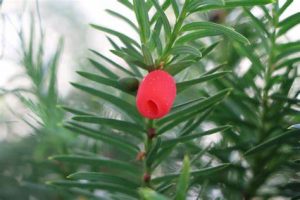
|
Canada YewHeight: 2m
The Canada Yew, also referred to as the American Yew or Ground Hemlock, is a small coniferous shrub which grows as an understory shrub from Ontario to Newfoundland. Preferring moist, loamy soils, this species is found along shorelines, riparian zones, marshes, and swamps. Rarely reaching heights of 2.5 meters, this species produces sprawling, staggering branches sprouting from a multi-stemmed base. Leaves produced are flat, dark green needles, arranged in two flat rows on either side of the branch. Over the winter and spring, this shrub develops a scaly seed cone with each cone housing one seed. By late summer to early fall, the cones develop into a red berry. This shrub provides shelter and food for many different bird species. Though poisonous to humans when ingested, the Canada Yew is harvested for its toxins and used in cancer research.
|
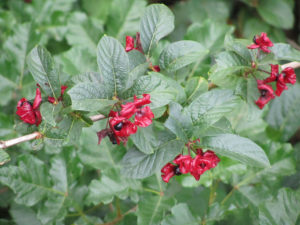
|
Bracted HoneysuckleHeight: 3m
Bracted Honeysuckle is a deciduous shrub species that typically grows about 3 m tall. This species may also be known by the common names: Twinberry Honeysuckle, Black Twinberry, or Bearberry Honeysuckle. The leaves are green, oppositely arranged, oval to broadly lance shaped, 5-10 cm long, sharply pointed, and have hairy undersides. The flowers appear out of the leaf axil in June to July. These flowers are tubular shaped, yellow colored, about 10 cm long, and have gland tipped hairs. The fruits of this plant are shiny, purple to black colored berries that are produced from July to September and appear in doubles or "twins". The flowers and berries are cupped by green to purplish red colored bracts. The berries of this shrub are beneficial for wildlife species including bears, small mammals, and birds. The flowers are also used by pollinator species like butterflies and hummingbirds. While wildlife use the berries for food, they may be mildly toxic to humans and should not be consumed.
|
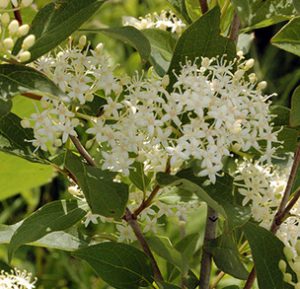
|
Gray DogwoodHeight: 2-3m
The Gray Dogwood, also referred to as Northern Swamp Dogwood or Panicle Dogwood, is a medium-sized, deciduous shrub which typically grows 2-3m. This species is multi-stemmed, with a full, round form. The leaves are green and arranged alternately along the branches. During the fall, leaves turn a bright red to deep purple colour. Between May and June, showy clusters of small white flowers bloom. These flowers turn into white fleshy berries late in the summer. The reddish-pink stems hold the berries throughout the winter, creating an artful contrast to the gray bark and snowy scenery. The Gray Dogwood is tolerant of a variety of environmental conditions and its complex, fibrous root system make it an ideal plant to use for controlling erosion.
|
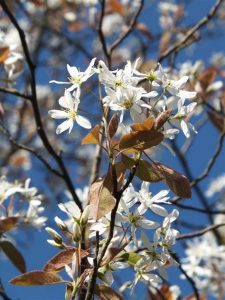
|
Canadian ServiceberryHeight: 3-5 m
The Canadian Serviceberry is a multi-stemmed shrub or small tree which grows from 3-5 m in a dense round form. This plant may also be known by the common names: Juneberry, Shadblow, or Shadbush. Early in the spring, prior to leaf development, clusters of fragrant, showy white flowers bloom along the branches. By July, these flowers give way to the fruiting bodies. The fruits are initially small, green berries, which grow to the size of blueberries and turn a deep purple-blue upon maturation during the fall. Leaves produced are finely toothed and spear-shaped. Throughout the summer, leaves are dark green and turn a dramatic orange-red during the fall.
|
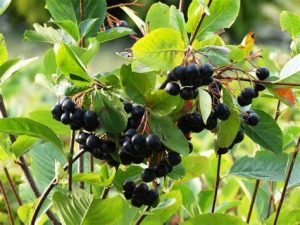
|
ChokecherryHeight: 6-9 m
The Chokecherry is a large deciduous shrub or small tree which grows between 6 and 9 m tall and is a member of the Rose family. It produces a twisted or crooked trunk as well as a narrow, oval to round crown composed of many slender branches. Leaves are alternately arranged, simple, have a deep green upper surface, and light matte green undersides with tufts of hair at the vein axils. During the fall, foliage turns a vibrant deep red to fire yellow or orange. Between May and June, small showy white flowers grow in cylindrical clusters on the terminal ends of branches. By mid-August, flowers turn into shiny deep red or black cherries, which hang in elongated clusters. The fruit is ripe by September and provides a food source for birds and small mammals. The Chokecherry is often found as pure stands forming thickets, or mixed with other early succession shrub and tree species. This fast-growing plant can quickly invade logged land, abandoned farms, and exposed shorelines. The fibrous and wide-spreading root system of this shrub make it an ideal plant for erosion control and bank stabilization. This species possesses the ability to withstand moderate flooding and drought.
|
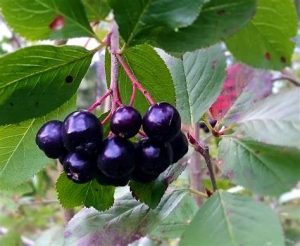
|
Black ChokeberryHeight: 1-3m
The Black Chokeberry is a medium sized deciduous shrub that typically grows between 1-3m with edible fruit. This species requires full sun to partial shade and can tolerate soil conditions from loamy and moist to rocky and dry. Naturally, Black Chokeberry is found in wet wooded areas such as; swamps, along shorelines, and within forest understory. This species is multi-stemmed, and forms thickets from stems which arise from the roots. Leaves are simple, growing alternately along the branch turning a bold red to orange during the fall. During spring, clusters of showy, white flowers appear turning into dark purple berries by fall. This species is resistant to drought, insects, pollution, and disease. The Black Chokeberry is often cultivated as an ornamental plant and food product. Additionally, this species is useful for bank stabilization and erosion control applications.
|
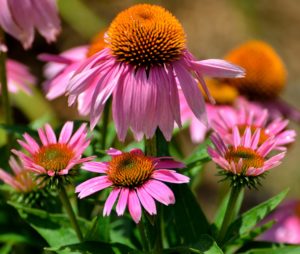
|
Purple ConeflowerHeight: 1m
Purple Coneflower is a perennial wildflower that typically grows about 1 m tall. This plant may also be known by the common name Echinacea. The leaves are dark green coloured, alternately arranged, lance shaped with pointed tips, and have serrated margins. The flowers are showy, pale purple to pink, have 15-20 toothed petals, appear atop erect stems, and bloom between June and August. This wildflower spreads well and can be used to naturalize un-vegetated areas. The roots can be useful for controlling erosion and stabilizing shorelines. This flower blooms for long periods. The flowers are beneficial to pollinator species, like bees and butterflies. The seeds are also beneficial to wildlife species, like birds and small mammals.
|
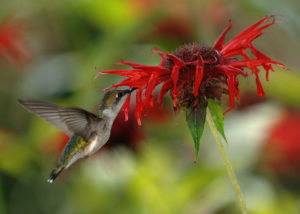
|
Oswego Tea (Red Bergamot)Height: 50 cm
Oswego Tea is a showy perennial wildflower species that typically grows about 50 cm in height. This plant may also be known by the common names Red Bergamot or Scarlet Beebalm. The leaves are dark green, oval shaped, have a minty fragrance. The unique flowers are bright red and grow in dense rounded clusters, with individual tubular flowers that bloom between May and October. The beautiful flowers of Oswego Tea attract various pollinator species like hummingbirds, butterflies, and bees. The Oswego Tea plant is susceptible to a common fungal disease, called powdery mildew, when planted in dry soils. Historically, the leaves of the plant have been used for antiseptic purposes, as well as poultices to heal minor wounds and skin infections.
|
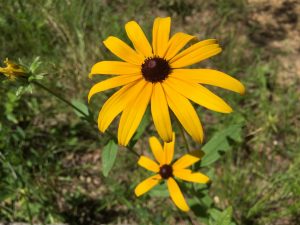
|
Black-Eyed SusanHeight: 1 m
Black-Eyed Susan is a popular biennial or a short-lived perennial wildflower species that typically grows about 1 m in height. Its leaves are green, alternately arranged, lance shaped, and covered with bristly hairs giving the leaf a grey/green colour. The flowers are daisy-like, have 8-20 yellow ray florets surrounding numerous dark brown disk florets, and blooms between June and September. The flowers are beneficial to pollinator species, like bees and butterflies. The seeds are also beneficial to wildlife species, like birds and small mammals. This flower blooms for long periods.
|
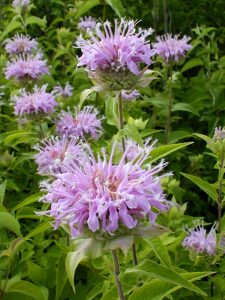
|
Wild BergamotHeight: 1 m
Wild Bergamot is a perennial wildflower species that is member of the mint family and can grow about 1 m tall. Its stems are light green and smooth with abundant branching on the upper half. The leaves are oppositely arranged, broadly lanceolate shaped, 6-10 cm long, and have toothed edges. The also leaves emit a aromatic minty/oregano scent when crushed. The flowers are showy, pink/lavender coloured, appear on the ends of flowering stems, and bloom between July and September. The flowers bloom in the center of the head first, moving outwards creating a wreath. The flowers are beneficial to pollinator species, like bees and butterflies. This wildflower spreads well and can be used to naturalize un-vegetated areas. The roots can be useful for controlling erosion and stabilizing shorelines.
|
Compartment A
Naturalization Area
 pH: acidic
pH: acidic Depth: potted
Depth: potted-
 Moisture: normal, moist
Moisture: normal, moist -
 Soil Type: sandy, loamy
Soil Type: sandy, loamy -
 Light conditions: partial sun
Light conditions: partial sun
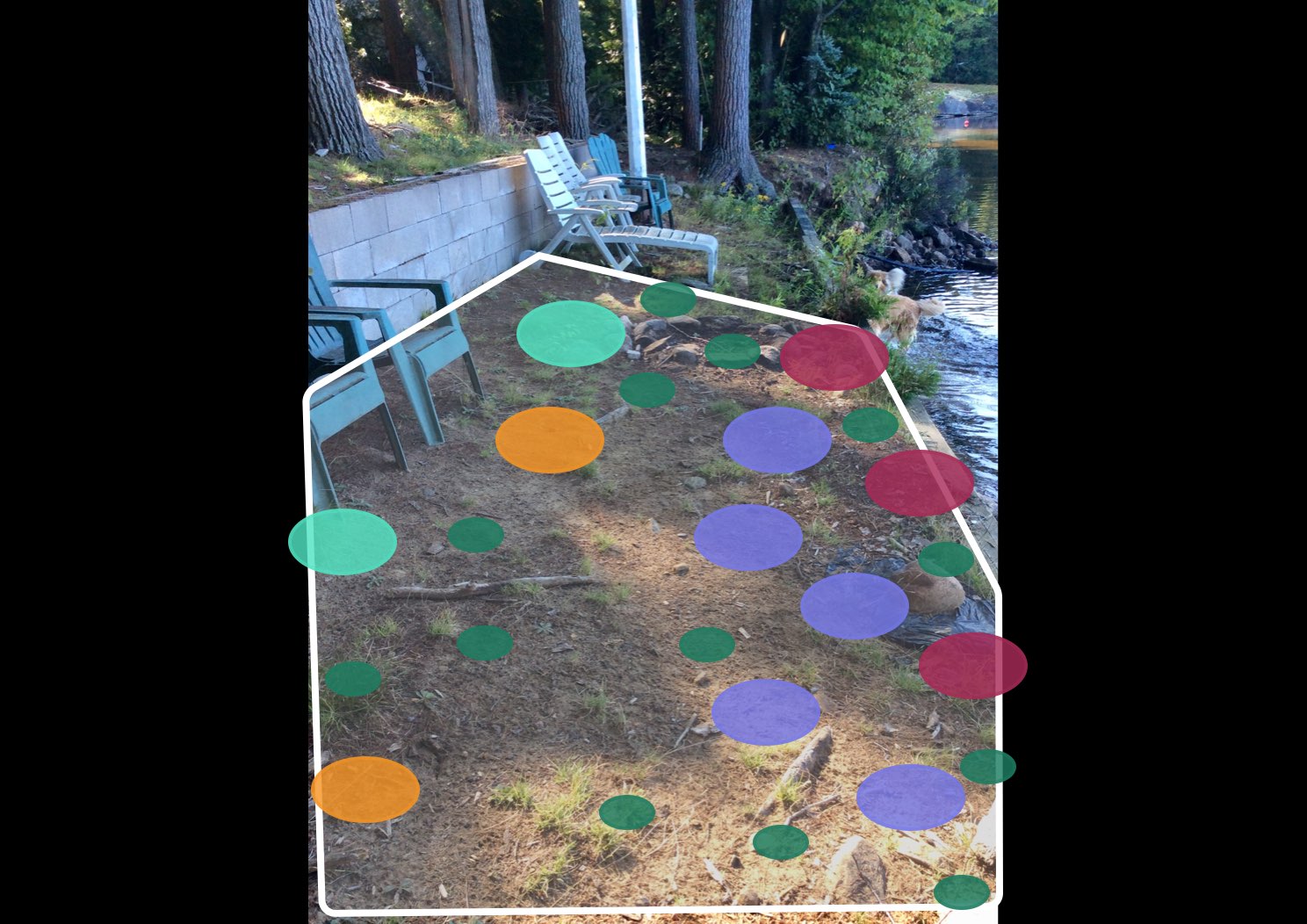
Compartment B
Naturalization Area
 pH: acidic
pH: acidic Depth: potted
Depth: potted-
 Moisture: normal, moist
Moisture: normal, moist -
 Soil Type: sandy, loamy
Soil Type: sandy, loamy -
 Light conditions: partial sun
Light conditions: partial sun
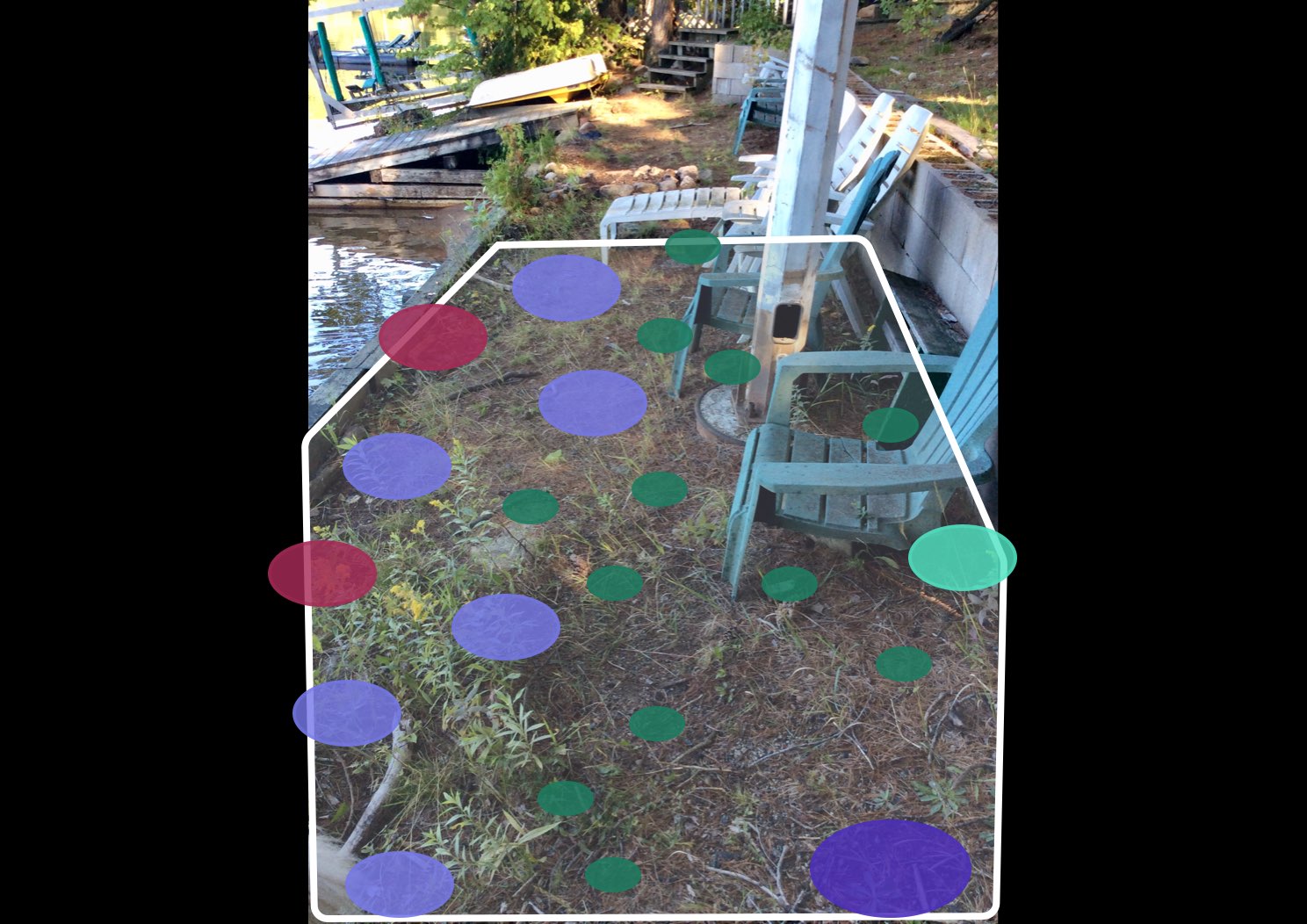
Compartment C
Naturalization Area
 pH: acidic
pH: acidic Depth: potted
Depth: potted-
 Moisture: normal
Moisture: normal -
 Soil Type: sandy, loamy
Soil Type: sandy, loamy -
 Light conditions: partial sun, shade
Light conditions: partial sun, shade
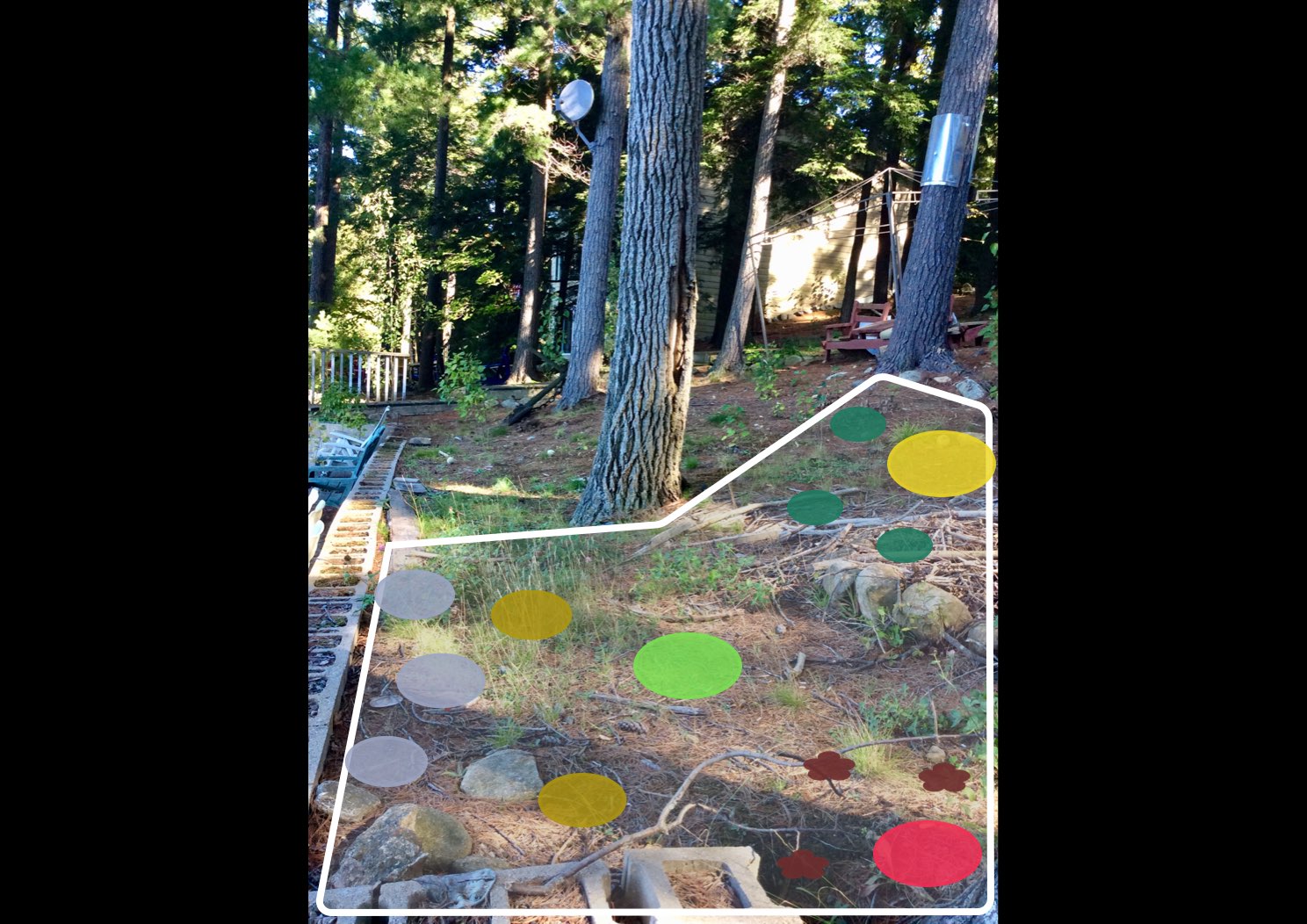
Compartment D
Naturalization Area
 pH: acidic
pH: acidic Depth: potted
Depth: potted-
 Moisture: normal
Moisture: normal -
 Soil Type: sandy, loamy
Soil Type: sandy, loamy -
 Light conditions: partial sun
Light conditions: partial sun
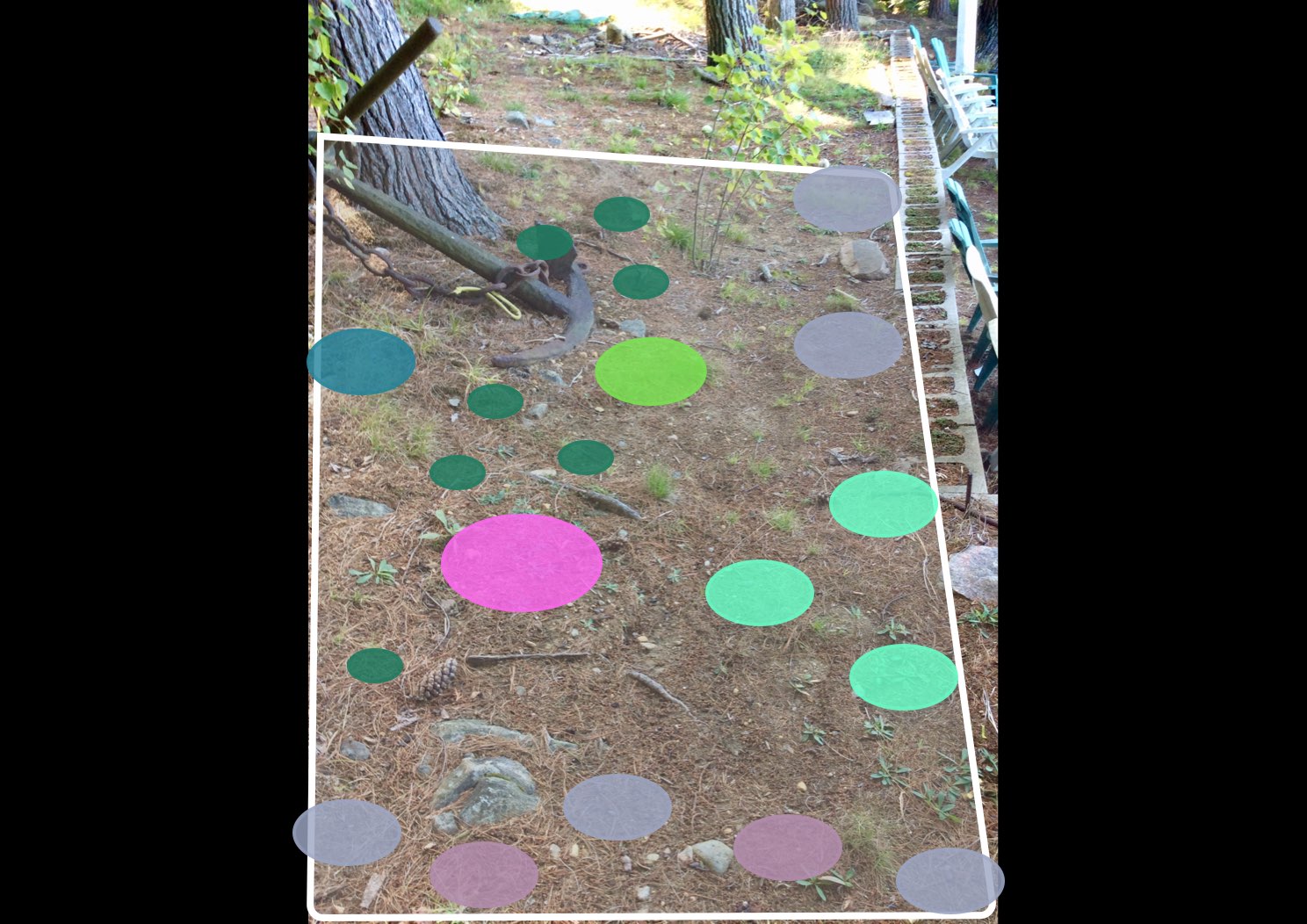
Compartment E
Naturalization Area
 pH: acidic
pH: acidic Depth: potted
Depth: potted-
 Moisture: normal
Moisture: normal -
 Soil Type: sandy, loamy
Soil Type: sandy, loamy -
 Light conditions: partial sun
Light conditions: partial sun
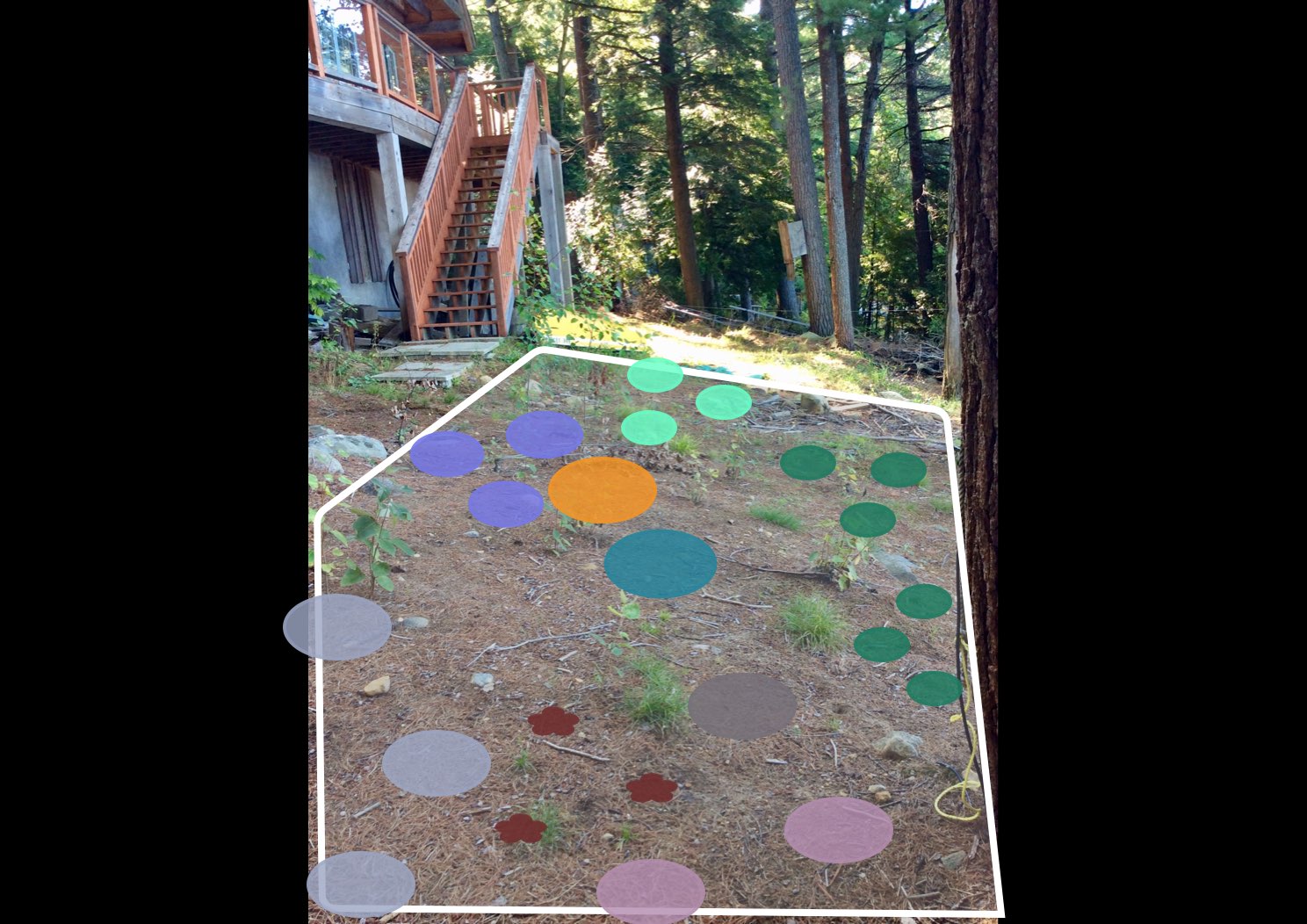
Compartment F
Naturalization Area
 pH: acidic
pH: acidic Depth: potted
Depth: potted-
 Moisture: normal, moist
Moisture: normal, moist -
 Soil Type: sandy, loamy
Soil Type: sandy, loamy -
 Light conditions: partial sun
Light conditions: partial sun
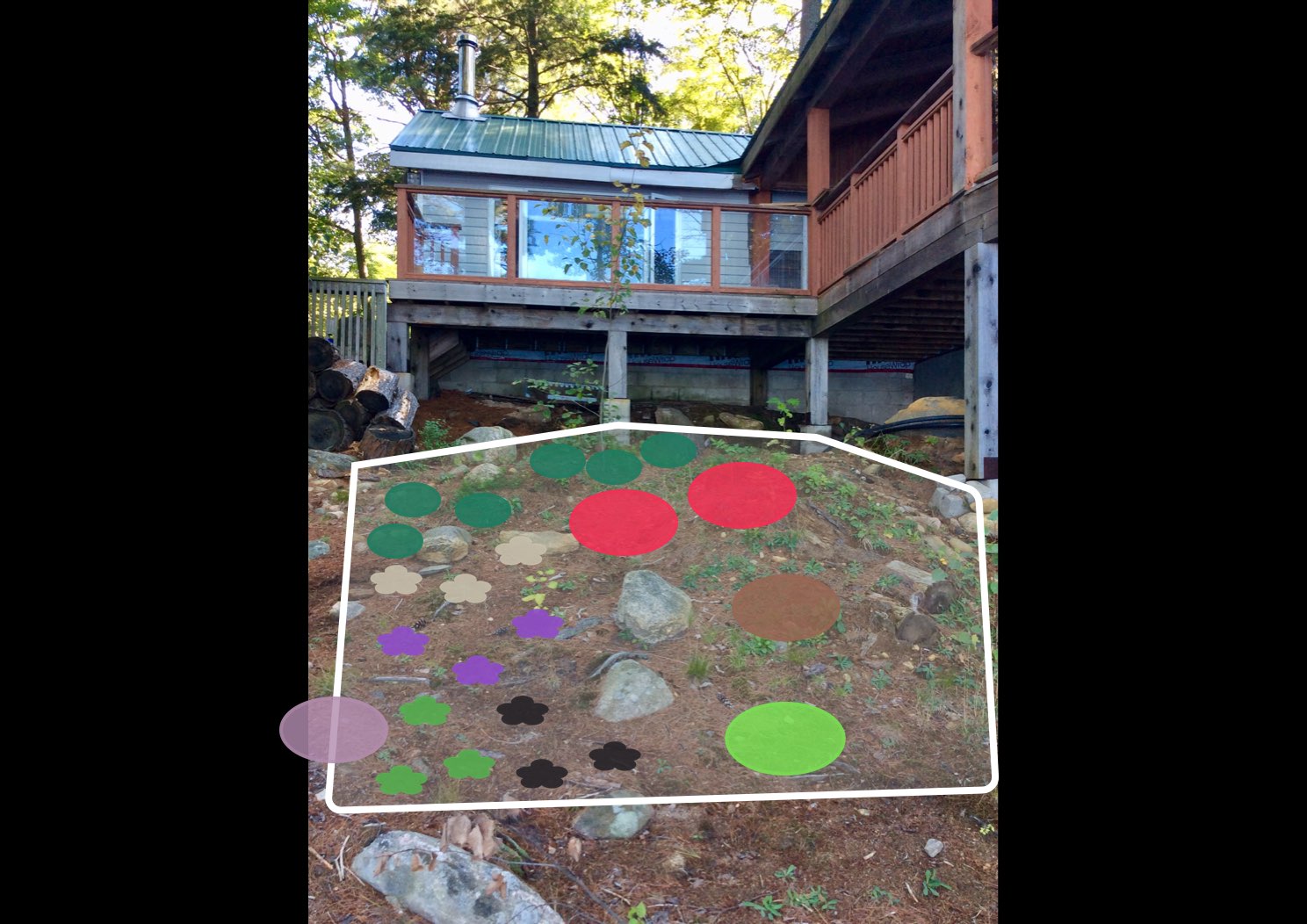
Schedule B
Financial Summary
Project by: The District Municipality of Muskoka
Shoreline Re-Naturalization Starter Kit includes: free site visit, customized re-naturalization planting plan for your shoreline property, native plants including free bare root (small) and potted (large) plants and wildflowers, coconut fibre pads to deter grass from growing around new plantings, tree guards for all deciduous trees, mulch for your wildflowers, Plant Care Guide with instructions on how to take care of your new plants, Habitat Creation Guide and a Wildflower Garden Guide.
Our planting plans are created onsite with you and provide detailed information and plans to re-naturalize your shoreline property. We take photos of areas for planting and overlay native plants that are well suited to your property based on site conditions such as soil type and sunlight availability.
We will work with you to create a plan that works for you including options for low growing plants in areas where views are important.
| Item | Quantity | Cost/Item | Subtotal |
|---|---|---|---|
| Starter Kit fee | $300 | ||
| Free potted plants | 20 | $0 | $0 |
| Paid potted plants | 89 | 12.00 | 1068.00 |
| Free bareroot plants | 0 | $0 | $0 |
| Free wildflowers | 18 | $0 | $0 |
| Total costs | 1368.00 |
Schedule C
Project Agreement
Stewardship Agreement
Please indicate your agreement to this proposed plan by signing the following Stewardship Agreement and submitting it, along with your financial contribution, to:
The District Municipality of Muskoka
70 Pine Street
Bracebridge, Ontario
P1L 1N3
Plant Availability
Please note that plant species may need to be changed based on plant stock availability at the time of ordering.
Project Completion
Upon receiving your signed stewardship agreement and financial contribution, a date will be booked for you to pick up your Natural Edge Kit. The District Municipality of Muskoka will supply all plants and materials. If you are paying for the planting to be completed for you, a date will be arranged for The District Municipality of Muskoka to plant your shoreline, bringing the plants and materials with them. If there are particular dates that you would prefer, we will do our best to accommodate your requests.
The Natural Edge Stewardship Agreement with The District Municipality of Muskoka
Agreement made this Day of the Month of in the Year .
BETWEEN Frank Lam 1111 Buckeye Road #10 MacTier Ontario (Hereinafter called the OWNERS)
AND The District Municipality of Muskoka 70 Pine Street Bracebridge, Ontario P1L 1N3 (Hereinafter called DMM)
WHEREAS the Owners and DMM have met and discussed plans for shoreline naturalization on the specified area(s) in Schedule A existing on the Owners’ land;
WHEREAS the Owners indicate approval of the project as proposed; and
WHEREAS the project is, or will be for the benefit of the Owners and others;
NOW THEREFORE THE PARTIES AGREE AS FOLLOWS:
1. This Agreement shall be in effect for a period of 5 years, commencing with the date of this Agreement.
2. The Owners and DMM agree that the areas where the work is to be performed is as described in Schedule A.
3. The Owners agree to pick up their Natural Edge Starter Kit from DMM’s office and plant their shoreline within two days of receipt. The Owners will provide “after” photos of the work completed to be used for reporting purposes. If the Owners wish to have the planting completed for them, then DMM or it’s contractors, employees and agents will complete the planting at cost, as indicated in Schedule B.
4. If the planting is to be completed by DMM, then the Owners grant DMM, its contractors, employees and agents, the right to enter the property to perform the work agreed upon as outlined in Schedule A. In addition, DMM, its contractors, employees and agents may inspect the work performed for the purposes of monitoring the project and survival assessment, with prior agreement with Owners for date and time of inspection.
5. The Owners agree to contribute the “Landowner contribution” and pay the costs indicated in Schedule B.
6. In instances where the Owners are to pay DMM for work to be performed (outlined in Schedule A), the Owners agree to provide payments to DMM prior to the commencement of that operation. Failure of payment shall constitute a breach of this Agreement and the Owners agree that this Agreement will be terminated and thereupon the Owners agree to pay DMM the estimated costs of the operations of the project completed to date, if any.
7. The Owners agree, if necessary, to perform a reasonable amount of maintenance, which is described in the Native Plant Care Guide, available at naturaledge.watersheds.ca.
8. If a contractor is required to perform the work outlined in Schedule A, then the contractor carrying out the work on the land described will be required to take out and furnish evidence of a comprehensive policy of public liability and property damage coverage. The contractor and their workers will be required to be in good standing with the Workplace Safety and Insurance Board (WSIB) prior to performing the work.
9. The Owners agree not to remove, destroy or alter the project without prior consultation and approval of DMM. Pruning and trimming planted nursery stock, or adding replacement native nursery stock is exempt.
10. The Owners agree not to mow the planted area.
11. The Owners do acknowledge that DMM, its contractors, employees and agents, having performed said works, are not under further obligation with respect to survival of nursery stock, inspection, or maintenance.
12. The Owners, in the absence of negligence, hereby remise, release and forever discharge DMM, its contractors, employees and agents from all claims and demands for injuries, including death, loss, damages and costs in any way related to or connected with installation and maintenance of the work described or resulting from any deleterious effects of the work to the land or to the lands and buildings thereon retained by the Owners.
IN WITNESS WHEREOF the parties have agreed to the contents of this plan; SIGNED:
About this program
About The District Municipality of Muskoka
The District of Muskoka is an upper-tier municipality that has monitored water quality in Muskoka area lakes since 1980. Since 2002, the Muskoka Water Strategy has provided integrated and strategic initiatives for the protection of Muskoka's water resources. The purpose of the strategy is to guide and minimize the impact of human activities on water resources; ensure human and environmental health; and preserve the quality of life in Muskoka.
This program was created by Watersheds Canada
We believe that every person has the right to access clean and healthy lakes and rivers in Canada. At Watersheds Canada, we work to keep these precious places naturally clean and healthy for people and wildlife to continue using for years to come. We love working with others to meet the needs of local communities, whether you’re a concerned citizen, a landowner, a lake association looking for help, or a coalition of groups interested in activating your local community.

